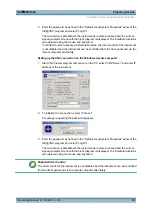
Manual Operation
R&S
®
SMC100A
53
Operating Manual 1411.4060.32 ─ 04
●
Pressing the rotary knob activates the selected entry field.
Depending on the parameter, the submenu is called, the numeric value varied, the
list entry selected or the check box activated or deactivated.
●
If a value is entered, the entry is stored by another click on the rotary knob and the
editing mode is exited.
Clear settings with the aid of independent subdialogs
A separate window is opened for each dialog and subdialog. The dialogs can be operated
independently of each other, i.e. none of the dialogs requires that settings in other dialogs
be completed before it can be closed. This ensures flexible operation at all times.
Keys with assigned simple functions
Most keys on the front panel of the R&S SMC directly perform a simple function.
Since a great number of settings can thus be made by a keystroke, operation is easy.
For instance, the CLOSE (ESC) key closes the active menu; with the RF ON/OFF (CTRL
+R) key the RF output signal can be switched on or off.
An exception are keys that call a menu such as the MENU (CTRL+M) key which opens
the complete menu tree of the instrument, the SETUP (CTRL+E) key which opens the
menus for general instrument settings or the FILE (CTRL+S) key which opens the menu
for file management.
Help functions for user support
Numerous help functions support the user in signal configuration.
●
Value ranges
The valid setting range is displayed for each numeric parameter. This requires a short
wait after activation of the entry field. The range is then displayed automatically after
a few seconds.
If the entered value is outside the permissible range, the next permissible value is
automatically set and a message is output.
●
Context-sensitive help
Context-sensitive help for each parameter can be called with the HELP or F1 key.
●
Comprehensive online help
Each help page is part of a comprehensive online help function which can be called
by means of an index, a content tree or the "Previous/Next" buttons.
Info line with messages for indication of the current instrument state
A great variety of different messages such as status messages, error messages, warn-
ings or information are displayed in the header field of the screen. With the aid of the
INFO (CTRL+I) key, help pages can be called for most of the messages. They provide
background information on the message and indicate operating steps that may be
Key Features






























